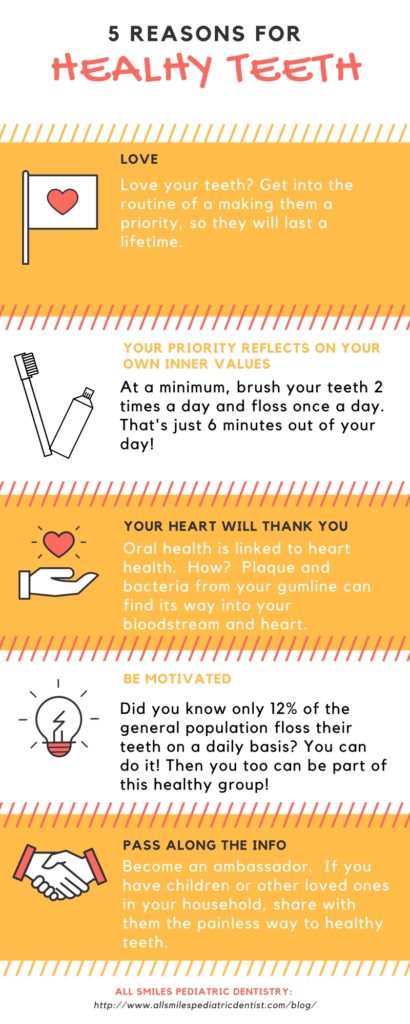Five Reasons for Healthy Teeth
February 16th, 2018
5 Reasons for Healthy Teeth
[caption id="attachment_548" align="aligncenter" width="410"] 5 Reasons for Healthy Teeth[/caption]
5 Reasons for Healthy Teeth[/caption]
1. Love.
Love your teeth? Get into the routine of making them a priority, so they will last a lifetime. Honor your body. By taking care of your body using preventive measures, you will not only enjoy good health, but feel great. You deserve it!
2. Your Priority Reflects On Your Own Inner Values.
At a minimum, brush your teeth two times a day and floss once a day. That's just 6 minutes out of your day! Want to find about more techniques? Check out our website's preventive care page.
3. Your Heart Will Thank You.
Oral health is linked to heart health. How? Plaque and bacteria from your gumline can find its way into your bloodstream and heart. Gum disease can lead to bone loss causing teeth to feel loose. Learn more about how to keep your gums healthy by reading gum disease on our website.
4. Be Motivated.
Did you know only 12% of the general population floss their teeth on a daily basis? You can do it! Then you too can be part of this healthy group.
5. Pass Along the Information.
Become an oral health ambassador. If you have children or other loved ones in your household, then share with them the painless way to healthy teeth.
There are more ways to have healthy teeth. Continue to checkout our blog posts for more information. Our website also great info on oral hygiene and diet recommendations.
At All Smiles Pediatric Dentistry, we incorporate proven techniques to share with you and your child at each dental checkup visit. Dr. Allen Job and his team are committed to providing the latest in oral health care prevention. For more information about brushing and flossing check out our preventive care page. Still want more information? Check out our blog posts on prevention! Our practice is centrally located in San Diego, CA.
Scheduling an appointment for your child is easy! Start here to schedule an appointment. All of our forms are online. Fill them out securely from your smartphone or tablet and hit send. On appointment day, your child will be seen at their scheduled time. For example, if you have a 9:00 AM appointment, your child will be seen at 9:00 AM.
 Dr. Allen Job, DDS, MS, MPH, MS is a board certified pediatric dentist who practices in San Diego, California, where he specializes in prevention. He is also an assistant professor at Loma Linda University Department of Pediatric Dentistry.
Dr. Allen Job, DDS, MS, MPH, MS is a board certified pediatric dentist who practices in San Diego, California, where he specializes in prevention. He is also an assistant professor at Loma Linda University Department of Pediatric Dentistry.






